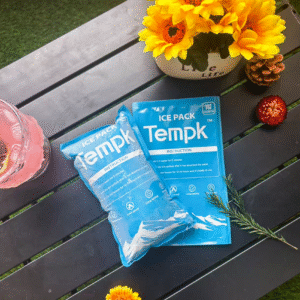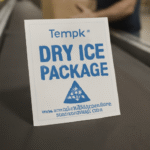كيف تعمل عبوات الثلج الجاف على تعزيز توصيل الأغذية والخدمات اللوجستية لسلسلة التبريد
Dry ice packs are a game-changer in food delivery, تلعب دورًا حاسمًا في الحفاظ على جودة وسلامة المنتجات القابلة للتلف. من خلال تقديم حل تبريد يفوق بكثير عبوات الثلج أو الجل التقليدية, يضمن الثلج الجاف بقاء البضائع المجمدة مثل المأكولات البحرية, اللحوم, وتبقى مجموعات الوجبات في حالة مثالية أثناء النقل. يستكشف هذا الدليل الفوائد, أفضل الممارسات, والاتجاهات المتطورة لاستخدام الثلج الجاف في توصيل الطعام, مساعدة الشركات على تحسين لوجستيات سلسلة التبريد الخاصة بهم.
-
ما هي أفضل الممارسات لاستخدام الثلج الجاف في شحنات المواد الغذائية?
-
كيف يمكن للشركات تحسين عملية توصيل الطعام باستخدام الثلج الجاف?
-
ما هي الاتجاهات الرئيسية التي تعيد تشكيل الخدمات اللوجستية لسلسلة التبريد؟ 2025?
لماذا تعتبر عبوات الثلج الجاف ضرورية لتوصيل الطعام؟?
لا غنى عن عبوات الثلج الجاف في صناعة توصيل الأغذية, وخاصة بالنسبة للشحنات التي تتطلب التجميد أو التبريد. على عكس الجليد التقليدي, which melts into water and can lead to soggy packaging or contamination, dry ice remains solid while sublimating directly into carbon dioxide gas. This characteristic helps keep food at the required temperature for extended periods, reducing spoilage and ensuring product integrity.
Key Benefits of Dry Ice in Food Delivery
-
Superior Cooling Power: يحافظ الثلج الجاف على درجات حرارة منخفضة تصل إلى -78.5 درجة مئوية (-109.3° f), making it ideal for frozen foods like ice cream, اللحوم, والمأكولات البحرية. على عكس عبوات الثلج أو الجل, which can only keep products cool for short periods, dry ice ensures products stay frozen for longer durations, مما يجعلها مثالية للشحنات لمسافات طويلة.
-
لا يوجد مياه ذائبة: One of the major drawbacks of using regular ice is the water it leaves behind. الجليد الجاف, لكن, sublimates directly into gas without leaving any liquid residue, preserving both the integrity of the packaging and the freshness of the products.
-
كفاءة التكلفة: While dry ice may seem expensive at first glance, it’s a cost-effective solution for shipping frozen foods over long distances. It provides a consistent cooling environment and reduces the risk of spoilage, potentially saving businesses significant costs related to waste.
Best Practices for Using Dry Ice in Food Shipments
To optimize dry ice use, businesses must follow industry best practices to ensure food products stay fresh and comply with safety regulations.
1. How Much Dry Ice Should Be Used?
The amount of dry ice required depends on various factors such as shipment size, مدة العبور, and the type of food being shipped. كقاعدة عامة, 5 ل 10 pounds of dry ice should be used per 24 ساعات الشحن. For longer shipments or larger orders, more dry ice may be needed.
2. Proper Packaging for Dry Ice
It is essential to use insulated packaging to slow down the sublimation rate of dry ice, ensuring that the cold air is retained for as long as possible. The packaging should also be ventilated to allow the carbon dioxide gas to escape and avoid dangerous pressure buildup.
3. Labeling and Safety Guidelines
Shipping packages containing dry ice must be labeled with the appropriate “ثاني أكسيد الكربون الصلبة” رموز الخطر. This is required by international shipping regulations to ensure proper handling and to inform all parties about the presence of dry ice, which can be hazardous if not managed correctly.
4. مراقبة درجة الحرارة
للحصول على نتائج مثالية, temperature monitoring devices should be included in shipments. These devices track the temperature throughout transit, allowing businesses to ensure that food stays within the required temperature range and enabling quick corrective actions if needed.
5. Safe Handling by Recipients
Educating recipients about the safe handling of dry ice is crucial. لأن الثلج الجاف يتصاعد إلى ثاني أكسيد الكربون, it is important to store it in a well-ventilated area and avoid touching it directly with bare skin. Clear instructions should be provided on how to handle and dispose of the dry ice safely.
أفضل ممارسات التعبئة
| عامل التعبئة | الممارسة الموصى بها | لماذا يهم |
|---|---|---|
| كمية من الثلج الجاف | يستخدم 5-10 رطل لكل 24 ساعات | يمنع تقلبات درجات الحرارة |
| Packaging Insulation | استخدام معزول, ventilated boxes | Retains cold for longer and avoids pressure buildup |
| وضع العلامات | Properly mark with “ثاني أكسيد الكربون الصلبة” ملصق | Ensures safe handling and compliance |
| يراقب | تشمل أجهزة مراقبة درجة الحرارة | Provides real-time data on shipment conditions |
How to Optimize Food Delivery Processes with Dry Ice
To streamline the food delivery process and ensure that shipments arrive fresh, businesses need to adopt a strategic approach.
1. تحليل بيانات الشحن التاريخية
Review past shipments to identify patterns in temperature fluctuations, dry ice usage, and packaging efficiency. This data can help businesses fine-tune their cold chain processes, reducing costs and improving shipping performance.
2. Collaborate with Experts
Partnering with logistics providers who specialize in cold chain shipping can significantly improve efficiency. These experts can provide valuable insights into the best practices for using dry ice, helping businesses handle shipments with care and optimize the use of resources.
3. Training for Team Members
Proper training is essential for reducing errors and improving the efficiency of the dry ice packing process. Ensure that your team is well-versed in handling, التغليف, وضع العلامات, and regulatory compliance to minimize risks and enhance operational efficiency.
4. Technology Integration
Leveraging advanced logistics software can help businesses optimize dry ice usage. AI-driven platforms can predict dry ice requirements based on various factors, automate temperature tracking, and optimize shipping routes, all of which contribute to smoother and more cost-effective shipping processes.
Trends in Dry Ice Use and Food Delivery Practices in 2025
As the food delivery industry evolves, several new trends are emerging that impact how dry ice is used and how food is shipped.
الاستدامة والتغليف الصديق للبيئة
With growing concerns over environmental impact, many companies are turning to sustainable packaging solutions. Biodegradable materials and eco-friendly insulation are being used alongside dry ice to reduce the overall carbon footprint of food delivery operations.
مراقبة درجة الحرارة المتقدمة
The use of IoT-powered temperature monitoring systems is becoming more common. These systems provide real-time tracking and alerts if the temperature deviates from the desired range, helping businesses react quickly to prevent spoilage.
Interactive Packaging for Better Customer Engagement
Interactive packaging that allows customers to track their shipments and monitor temperature conditions is becoming a popular trend. This enhances the customer experience by providing greater transparency and increasing trust in the delivery process.
رؤى السوق
As the demand for fresh and organic foods continues to rise, the need for reliable and efficient cold chain logistics is becoming more critical. Businesses that adopt advanced cold chain technologies and best practices will be well-positioned to meet the increasing demand and stay competitive in the global market.
الأسئلة المتداولة
س 1: Why should I use dry ice for food delivery?
Dry ice is essential for keeping food frozen during transit, ensuring it remains fresh and safe. It provides longer-lasting cooling and avoids the water damage that traditional ice can cause.
Q2: How long does dry ice last in food delivery?
Dry ice can maintain low temperatures for 24–48 hours, depending on the amount used and the insulation in the packaging. It’s ideal for long-distance shipments that require extended cooling.
س 3: هل من الآمن التعامل مع عبوات الثلج الجاف؟?
نعم, as long as proper safety protocols are followed. ارتداء القفازات, use proper ventilation, and ensure that dry ice is handled in open, well-ventilated spaces to avoid injury or asphyxiation.
الخلاصة والتوصيات
Dry ice packs are indispensable for ensuring the safe transport of perishable foods, providing consistent, long-lasting cooling that traditional ice cannot offer. By following best practices such as proper packaging, وضع العلامات, ومراقبة درجة الحرارة, businesses can optimize their cold chain operations and ensure the quality of their products.
اقتراحات قابلة للتنفيذ:
-
Review and optimize your current food delivery processes by evaluating how dry ice can improve your shipping efficiency.
-
Invest in advanced temperature monitoring technology to maintain high-quality control throughout the shipping process.
-
Collaborate with logistics providers who specialize in dry ice shipments to ensure compliance and efficiency.
حول Tempk
و Tempk, نحن متخصصون في تقديم حلول سلسلة التبريد المبتكرة, offering high-quality dry ice packs and packaging solutions tailored to the food and pharmaceutical industries. Our products ensure that your goods remain fresh and safe, regardless of the shipping distance.
دعوة إلى العمل: Contact Tempk today to learn more about our dry ice packs and how we can help optimize your cold chain logistics.























